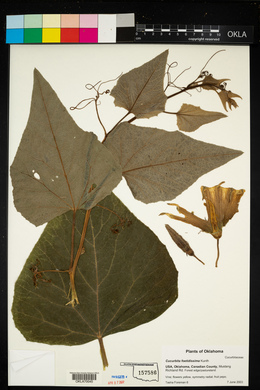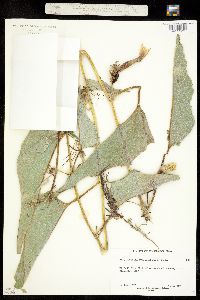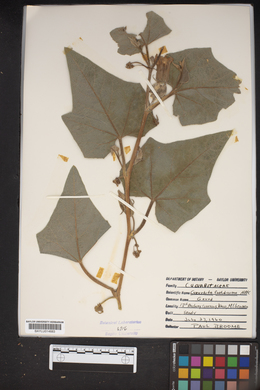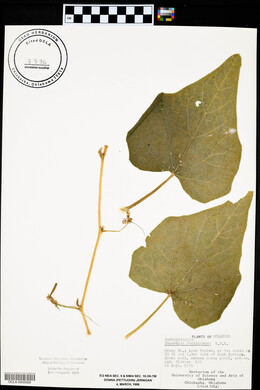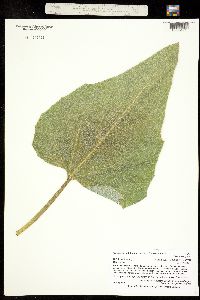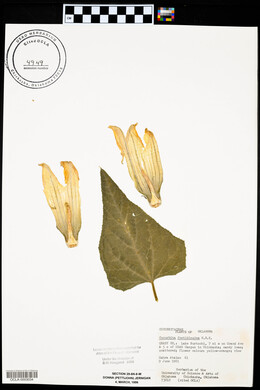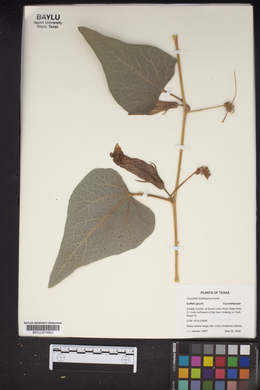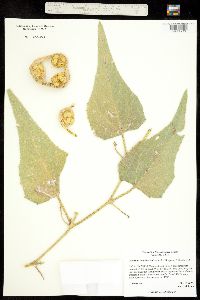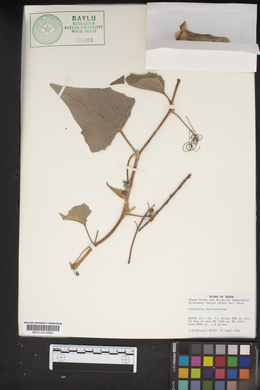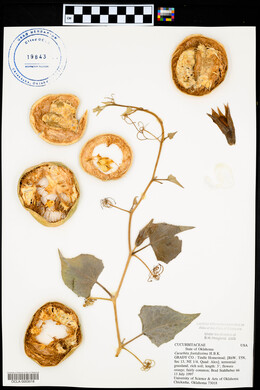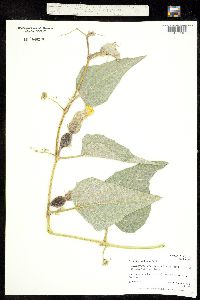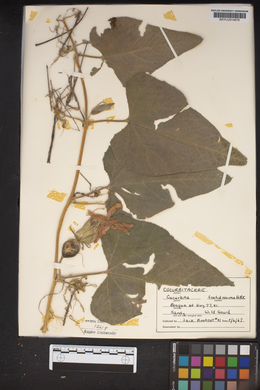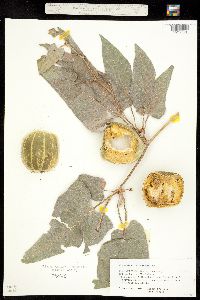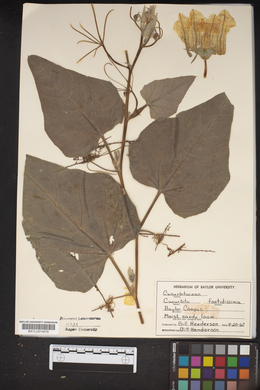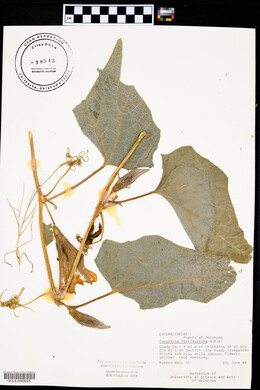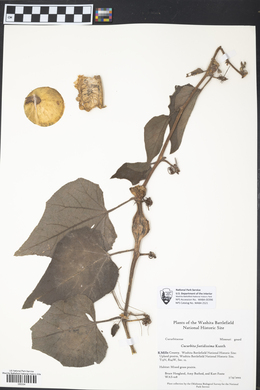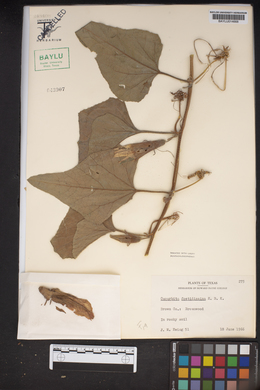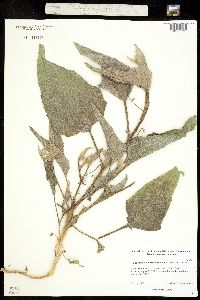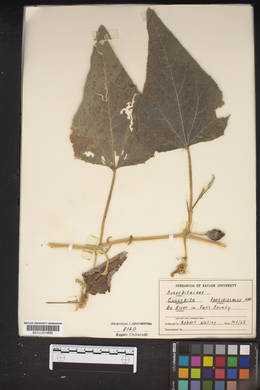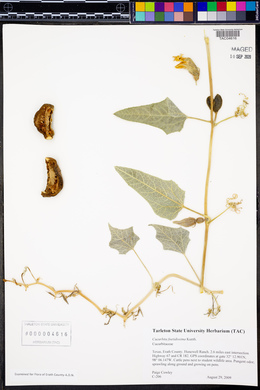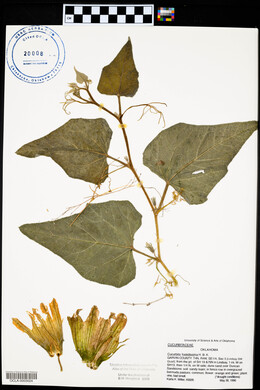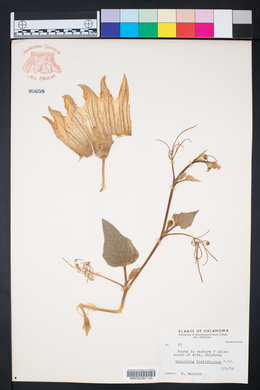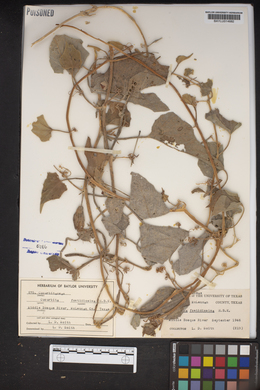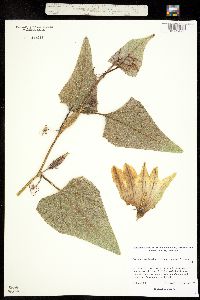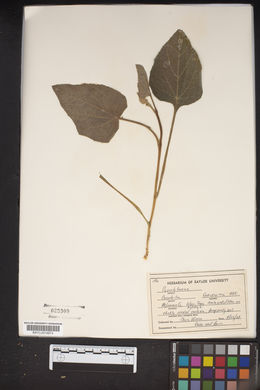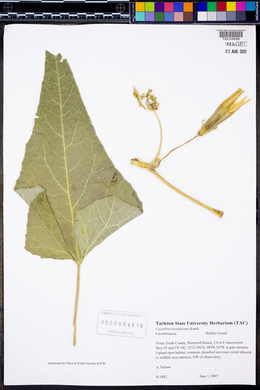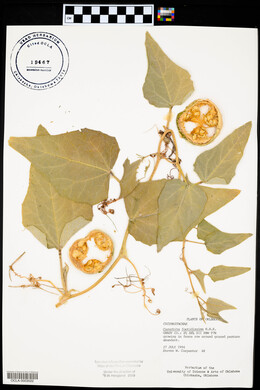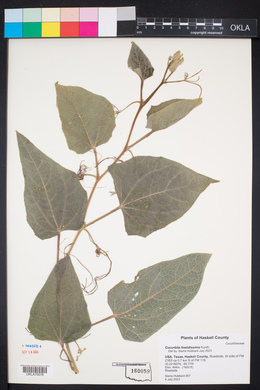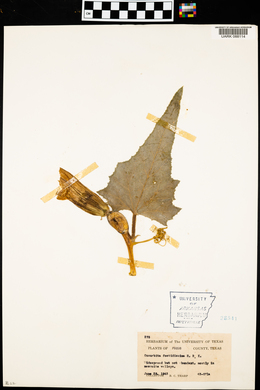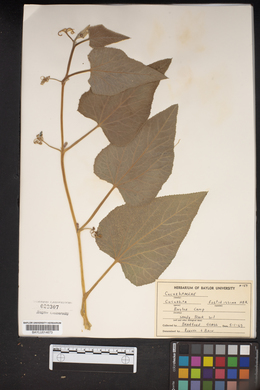Cucurbita foetidissima
|
|
|
|
Family: Cucurbitaceae
Missouri Gourd, more...buffalo gourd, buffalogourd pumpkin, calabazilla, wild gourd, wild pumkin (es: calabaza de coyote, calabaza amargosa)
[Cucumis perennis, morePepo foetidissima (Kunth) Britt.] |
Perennial herbaceous vine to several meters long Stem: rough. Leaves: alternate, 10 - 20 cm long, triangular-egg-shaped, irregularly and finely toothed, often with angular lobes, rough-hairy on both surfaces, slightly whitened beneath, foul-scented. Flowers: either male or female, found on the same plant (monoecious), borne solitary in leaf axils, yellow, 5 - 12 cm across, five-sepaled, with petals fused into a bell-shape that ends in five recurved lobes. Fruit: a nearly spherical berry with a rind (pepo), greenish orange, 5 - 10 cm long, smooth, many-seeded. Tendrils: branched. Similar species: Cucurbita pepo leaves lack an unpleasant odor and the petal lobes are erect to spreading. Citrullus lantanus and Cucumis melo have flowers that are flat and circular in outline and leaves lacking an unpleasant odor. Additionally, C. lantanus has deeply pinnate-lobed leaves, and C. melo has unbranched tendrils. Flowering: May to September Habitat and ecology: Introduced from the southern and western United States, this species is occasionally found around dumps and railroads. Occurence in the Chicago region: non-native Etymology: Cucurbita is the Latin name for the gourd. Foetidissima means very foul-smelling. Author: The Morton Arboretum Wiggins 1964, Heil et al. 2013 Duration: Perennial Nativity: Native Lifeform: Vine General: Rank-smelling perennial herbaceous vine, with a large, tuberous, deeply penetrating root; stems coarse, radiate, forming dense cover 30-40 cm high over several square meters; herbage scabrous with curved hairs. Leaves: Alternate along the stems and generally pointing upward, on thick scabrous petioles about half the length of the leaf blade; blades triangular, 10-20 cm long, evenly and progressively smaller toward the tips of stems, the upper surface densely and coarsely white-pubescent and the lower surface scabrous with conical trichomes along veins; each leaf paired with a thick coiled tendril which emerges from the stem just below the leaf petiole. Flowers: Large and yellow, solitary in the leaf axils, with separate male and female flowers the same plant (monoecious); sepals 5, green, united at the base, narrow and pointed at the tips, much shorter than the petals; petals 5, yellow, united into a large bell-shaped corolla, to 10 cm long. Fruits: Spherical gourd-like fuit, 6-8 cm across, green with conspicuous whitish stripes or white-mottling, drying yellowish; containing numerous flat ovate seeds. Ecology: Found in sandy soils, along fields, and in disturbed areas, from 1,000-7,000 ft (305-2134 m); flowers May-August. Distribution: Most of the southern half of the US from c CA, east to WI and IL, south to TX; south to s MEX. Notes: A frequent cucurbit vine (related to cultivated cucumbers) in many N. American regions; distinguished by its growth form with stems that creep along the ground forming sizeable patches; large, triangular leaves with finely toothed edges and stiff hairs making them sand-papery to the touch; green, striated fruits that are filled with a tough web of fibers. Also conspicuous because of the utterly foul smell of its flowers; if you crush one in your fingers and they'll stink for days. You can crush the leaves and soak them in water to make a spray that wards off squash bugs. Distinguish from other species of Cucurbita based on its triabgular leaves; other species in the region have deeply lobed leaves. Ethnobotany: Poultice of roots applied to boils and sores and used to soothe horses' backs; the ground fruit shell was used as shampoo and as an emetic; dried fruits used as a baby's rattle. Etymology: Cucurbita is the Latin name for gourd; foetitissima means evil-smelling. Synonyms: Pepo foetidissima Editor: SBuckley 2010, FSCoburn 2015, AHazelton 2017 Stems rough, trailing from a thick perennial root, often to several m; herbage malodorous; lvs triangular-ovate, 1-2 dm, irregularly and finely toothed and often angularly lobed, rough on both sides; fls yellow, campanulate, 5-10 cm long and wide; fr subglobose, 5-10 cm, greenish-orange, smooth. 2n=40, 42. Dry soil; Mo. to Tex. and Calif., and intr. along railways farther e. Summer. (Pepo f.) Gleason, Henry A. & Cronquist, Arthur J. 1991. Manual of vascular plants of northeastern United States and adjacent Canada. lxxv + 910 pp. ©The New York Botanical Garden. All rights reserved. Used by permission. |
|
|
|

















_tn.jpg)
